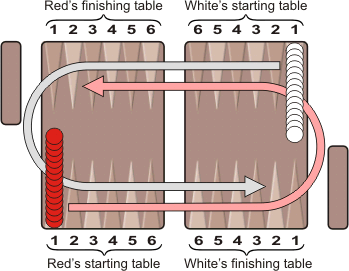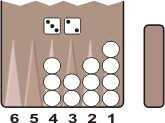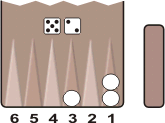![[Backgammon Galore!]](/gif/GaloreButton.gif)
|
|
Backgammon Variants Setup: Each player starts with fifteen checkers on the rightmost point of the far side of the board, at diagonally opposite corners from each other. They move in the same direction, counterclockwise, around the board.
Object: The object of the game is to move all of your checkers around the board to your own finishing table and bear them off. The first player to bear off all his checkers wins the game. To start: Each player rolls one die and the higher number goes first. That player then rolls the dice again to begin his first turn. Movement: The roll of the dice indicates how many points, or pips, the player is to move his checkers. The following rules apply:
If you are unable to play all of the numbers of a roll, you must play as many as you can and any unplayable numbers are lost. The courier: One checker, known as the courier, must be played first, and no other checker may be played until the courier has reached its finishing table. Hitting: A checker sitting alone on a point is called a blot. If an opposing checker lands on a blot, the blot is hit and placed on the bar. Entering from the bar: Any time you have one or more checkers on the bar, your first obligation is to reenter those checker(s) into your starting table. You enter a checker by moving it to an open point corresponding to one of the numbers on the rolled dice. If you are able to enter some but not all of your checkers, you must enter as many as you can then give up the remainder of your turn. Limits checker movement: The following rules limit how checkers may be moved:
You may not unnecessarily waste pips when bearing off. This means you should always bear off a checker where possible rather than use a smaller number to move that checker forward.
If one of your checkers is hit during bearoff, it must be reentered in your starting table and brought around the board again to your finishing table before you can resume bearing off. Scoring: The first player to bear off all his checkers wins the game and scores one point. A player wins marcia (2 points) if each bears off all his checkers before the opponent has borne off any, or marcia per punto (3 points) if he gets marcia without ever having constructed a prime. (A prime is six consecutive points with two or more checkers on them.) Modern Rules: Philippe Lalanne has a description of modern Jacquet rules which are quite different than the rules presented here. Philippe writes: "The rules I give are the ones used when I was a kid. At that time Jacquet was the most popular tables game in France. I think this is the best way to play. The original rules are from the beginning of the nineteenth century."
ReferencesBooks
World Wide Web
|
![]()
Backgammon Galore : Variants



